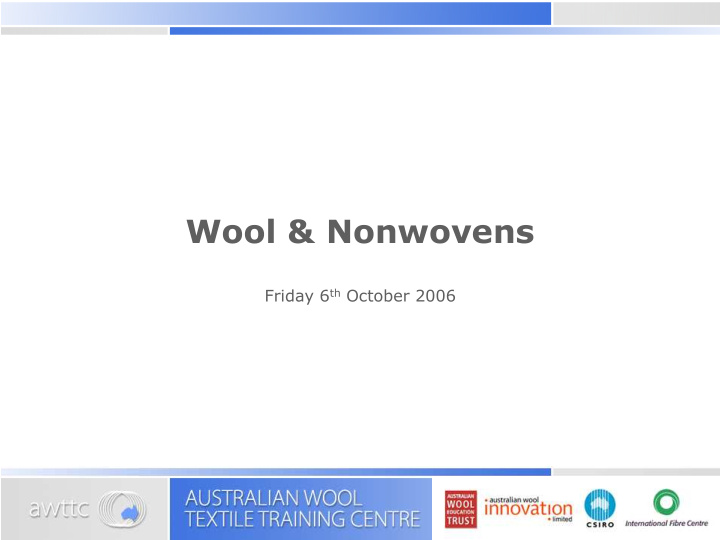



Wool & Nonwovens Presentation title to go here Friday 6 th October 2006
What is meant by “ Nonwoven ” § Nonwovens are textiles formed from fibres or filaments without going through a yarn stage. § Knits are not woven but they aren’t nonwoven § Nonwovens could be called non-spun except that the fibre manufacturing process is also called “spinning” § Nonwoven fabrics are produced without knitting or weaving
Nonwoven Processes § Web forming § Bonding § Finishing § Coloration
Web Formation - Carding Breast Main Cylinder Figure 1. Basic Nonwoven Card. This is the most common means of web formation.
Web Formation - Carding Schematic diagram of a typical nonwoven card with condenser rollers, (eg Thibeau, Spinnbau, FOR)
Web Formation - Carding A Random Card, has extra counter-rotating roller between cylinder and doffers.
Web Formation – Cross-Lapping Input web FROM WEB FORMATION Cross-Lapper TO BONDING Multi-Layer Output Web
Web Formation – Air-Lay Air-laid webs or batts have a more random fibre orientation distribution. They usually have high bulk as they have fibres oriented in the vertical direction.
Web Formation – Air-Lay Fehrer K12
Bonding Mechanisms suited to Wool § Needle Punch § Hydroentanglement § Stitch Bonding – yarns sewn into fabric § Thermal Bonding § fibres glued with low temperature melting component of bicomponent fibres included in blend. § Scrims: pre-woven or welded nets into which fibre webs are entangled to give extra strength and resilience.
Bonding – Needle Punch � To Wind-up or Needle further Board processing From Web Web Formation Compression
Bonding – Hydroentanglement � INJECTORS WEB IN DRUMS WITH TO DRIER SUCTION MESH BELT WITH SUCTION Hydroentanglement or “ Spunlace ”
Spunlace § High Specific Energy § No reciprocating parts § Very high speed possible § High power consumption § 4m wide line ~1.2MW § but high production rate means a few cents/kg operating costs
Common Spunlace products are: • Wipes, towels, tissues • Filters • Protective apparel • Surgical gowns and covers • Synthetic leather • Sanitary products • Home furnishings • Interlinings (some wool)
Spunlace + scrims • scrims to provide strength: • lower entanglement for bulk and softness with good recovery • Pre-stressed or shrinkable
Spunlace Wool Fabrics • scrims provide strength • Trade off with drape and flexibility
Stitch Bonding Meyer Maliwatt Stitch Bonding – yarns sewn into fabric. Like scrims, provide strength with flexibility
Stitch Bonding § Rows of threads are sewn into the fabric § Provides strength with flexibility, somewhat like a woven § Threads hidden in felt § Lower weight limits 200-300gsm § Threadless Stitch bonding: § The needles capture groups of fibres from the web itself and form stitches with them
Thermal Bonding materials § Bicomponent fibres § Intimate blend of fusible and conventional fibres § Low melt powder § Low melt film
Bicomponent cross sections § Core sheath § Side by side § Island in the sea § Pie segment
Through air bonding § Heated air is passed through the web to be bonded § Bonding is achieved by convection § Air flow in both directions or single direction § Dwell time inside oven § Fabric density § Maximum bonding is on surface
Through air bonding § Flat bed
Through air bonding § Perforated drum
Through air bonding
Recommend
More recommend